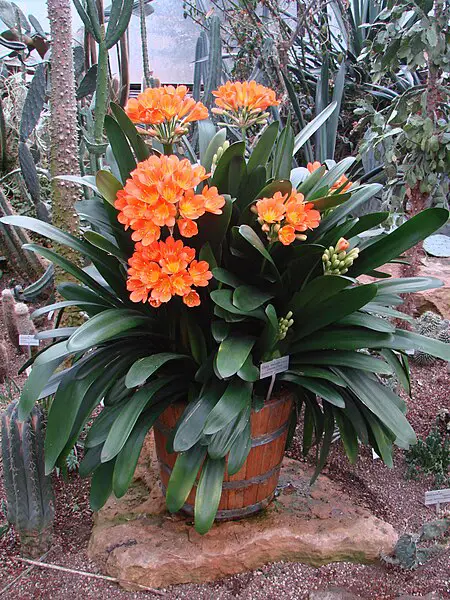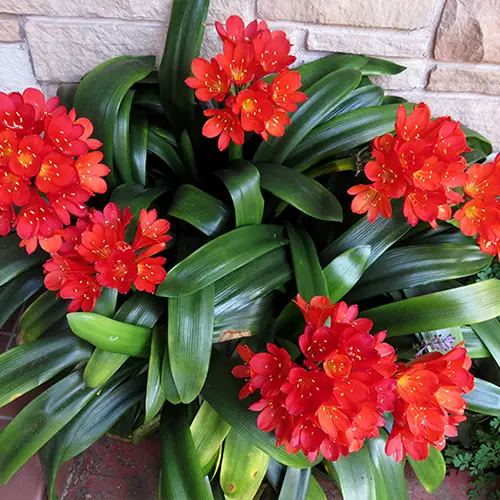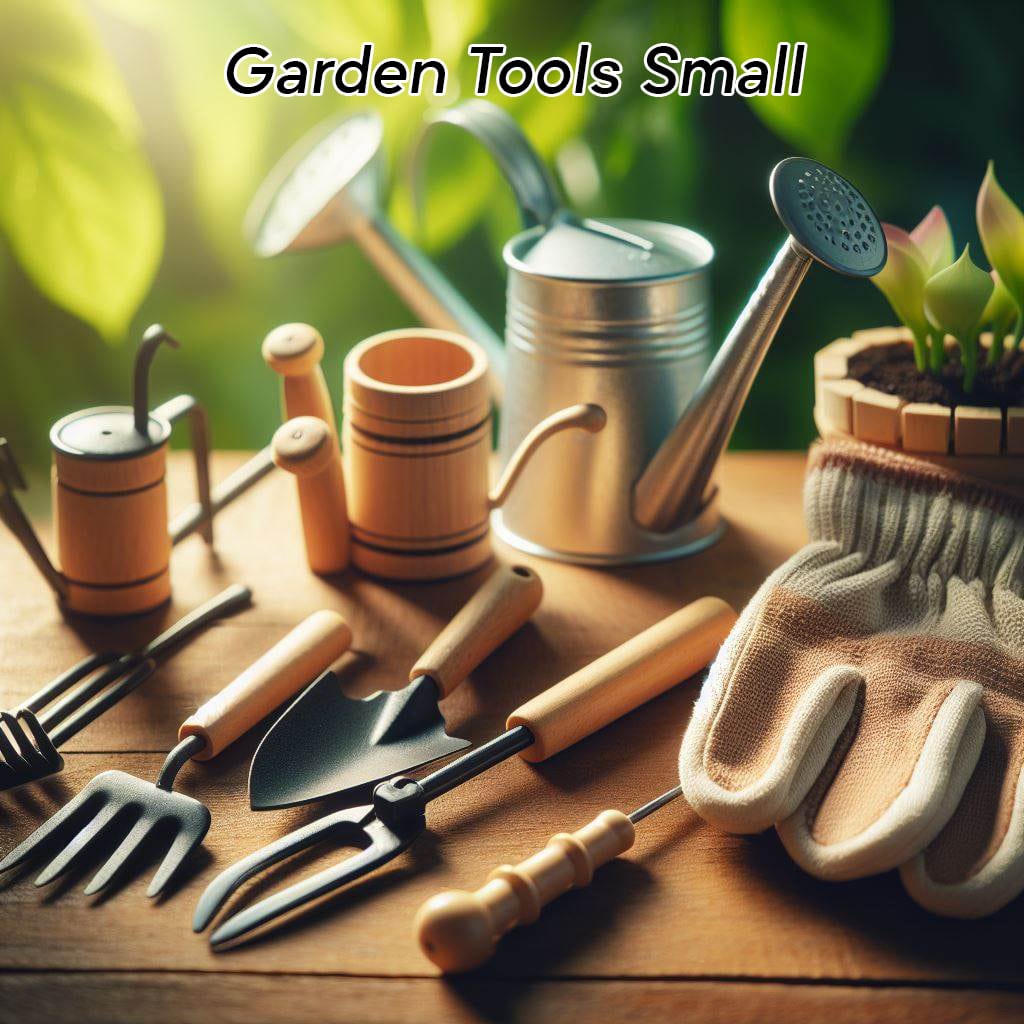
clivia plant?
Clivia miniata is a long-lasting, cultivated plant with a height of about 45 cm and a rhizome formation. It grows through the training of secondary branches. The plant has simple, dark green, glinting leaflets with a diameter of up to 6 cm. It has 10-20 flowers on a strong, upright flower stand, with radial, symmetrical, and three-countig flowers. The flowers are orange-colored and can last over a year. The fruit ripens at the fruit’s surface, and the seeds can be harvested in the fall. The plant can survive only in mild temperatures up to -2°C. It requires a lot of water in summer but should be kept relatively dry in autumn and winter to maintain its winter hardiness. The generative growth of the plant is slow, lasting usually a minimum of three years. The vegetative growth occurs through the separation of secondary branches, which form older plants. The roots are removed when the plants are strong enough and have their own roots.
| Ordnung | Spargelartige (Asparagales) |
| Familie | Amaryllisgewächse (Amaryllidaceae) |
| Unterfamilie | Amaryllidoideae |
| Tribus | Haemantheae |
| Gattung | Klivien (Clivia) |
| Art | Klivie |

What is Clivia?
Clivia miniata is a beautiful flowering plant that is easy to grow and more unusual than traditional holiday plants. It belongs to the lily family (Liliaceae), the same family as amaryllis, and produces dense clusters of orange, lilylike flowers when given a month of cool night temperatures in autumn and a six-to-eight-week rest period with very little water.
The straplike, dark evergreen leaves are virtually blemish-free, making clivia an attractive foliage plant even when not in bloom. Clivias are large, heavy plants that require a large, wide-based, clay pot that won’t tip over. They prefer to be kept rootbound and can remain in the same pot for up to five years. It is best to purchase a mature plant, unless you are very patient. Propagating clivias is difficult due to their slow growth and difficulty. It takes three to five years for them to bloom for the first time, while the big, marvelous plants take five to 10 years or more to reach that size.
Additionally, clivias cannot be tissue-cultured, which allows commercial growers to produce hundreds of plants from a single bud or cell, knowing that each new plant will be an exact duplicate of the parent. In the wild, clivias are native to the subtropical forests of eastern South Africa, where they can be found growing in organic material, in deep to partial shade, and sometimes on top of rotting logs. There is also a rare, yellow-flowered clivia growing wild in South Africa, and there is an extremely rare clivia with a variegated leaf in cultivation.

Spectracide Bug Stop Home Barrier, Kills Ants, Roaches and Spiders On Contact, Indoor and Outdoor Insect Control, 32 fl Ounce Ready-To-Use Spray Add to card Control Solutions Inc. 82770003 Stryker 54 Contact Insect Spray, Clear

Okatsune 103 Bypass Pruners General Purpose Medium Add to card GROWNEER 3 Packs 6.5 Inch Pruning Shears Add to card Gardening Hand Trowel and Stainless Steel Hand Cultivator Add to card Kings County Tools Mini

garden tools with long handles At ApartmentFollowers, you will find a wide range of high-quality gardening tools, including shovels, forks, rakes, and rakes, designed to increase user performance and comfort. The collection also includes long-handled

FiveJoy Garden Tool Set, 11 Piece Aluminum Alloy Steel Hand Tool Starter Kit with Garden Bag Add to card Senkichi Wooden Pattern Garden Mini Shovel Square 27.6 inches (698 mm) Add to card Barnel V3002SC
Benefits of Growing Clivia
Clivia, a low-maintenance plant, is ideal for borders, shaded clumps, tropical gardens, patios, and balconies. They grow well in containers, making them suitable for patio and balcony designs. Clivia flowers also last long as cut flowers, making them a versatile and cost-effective choice for gardens.
How to Grow Clivia?
The Natal lily (Clivia miniata) is a frost-tender house plant with stocky stems and large, rounded heads of colorful flowers from late winter to spring. Its foliage is architectural and attractive year-round, with wide, dark green, strap-shaped evergreen leaves that grow from a swollen, fleshy root. Clivia can live for many years and grows to around 45cm high and 30-40cm wide.
To grow Clivia, it should be grown under cover in a frost-free place, avoiding hot rooms, and in good light but out of direct sun. Water regularly in summer but sparingly in winter, when the plant should be’rested’ in a cool place. Feed in spring and summer, deadhead once flowering has finished, and propagate from offsets in spring.
Clivia needs a minimum temperature of 5°C and may suffer frost damage at lower temperatures. Place it in bright light but out of direct sunlight, avoid placing it in hot centrally-heated rooms or close to heat sources. Adjust watering to the season and giving the plant a’rest’ over winter is key to getting it to flower every year.
Repot and propagate Clivia only when absolutely essential, replacing the top 5-8cm of compost with fresh potting compost annually in early spring. Move up to the next pot size gradually, gradually increasing the size over time. Ultimately, Clivia thrives in a good-sized pot of at least 20cm in diameter. Repot in spring only when necessary, using a good quality, peat-free multi-purpose potting compost with added loam.
How To Plant Clivia?
Philodendron, a tropical plant with a wide variety of growing habits and leaf shapes, is mildly toxic to humans and dogs and cats. Symptoms of exposure include oral irritation, pain, swelling, excessive drooling, vomiting, and difficulty swallowing. Syngonium, also known as Arrow-head vine, is mildly toxic but similar to Philodendrons. ZZ Plant, also known as Sansevieria, is a tough houseplant that can survive in low light environments but is considered poisonous. Bird of Paradise, a tropical plant with large paddle-shaped leaves and exotic flowers, is not edible for pets and children.
Asparagus Fern, a plant in the Asparagus genus, is not edible and can cause skin irritation when exposed to its sap. Schefflera, a medium-light floor tree, can cause mouth irritation, excessive drooling, and vomiting. Euphorbia, a member of the Crassula genus, contains a white sap that causes skin irritation and can cause vomiting, depression, and incoordination. Jade plant, a classic member of the Crassula genus, is toxic to dogs, cats, and humans, causing vomiting, depression, and incoordination.
Aloe, a plant known for its medicinal properties, is listed among poisonous houseplants due to its gel being considered edible but causing vomiting, lethargy, and diarrhea when ingested.
Clivia Plant Care
Clivias are known for their rugged nature and require minimal attention. They thrive in bright daylight but little direct sun, and can be grown outdoors in shady locations. Watering is recommended only when the plant requires it, as it can cause rot and disease. Winter rest is recommended during October, November, and December, with a 3-month rest period yearly. The plant should be kept in a cool room with minimal water, and if it begins to wilt, add 1-2 cups of water.
After blooming, fertilize the plant monthly with a water-soluble fertilizer at ½ the recommended strength. Use restraint and stop fertilizing by mid-September. Grooming involves cutting flower stalks off at the base after blooms have faded and removing withered leaves. Clivias tolerate considerable crowding of their roots and bloom best when pot-bound. Repotting is necessary every 3-5 years, and after bloom, place the plant in a new pot no larger than the old one. Use a potting mix that drains well and is composed of at least 50% organic matter, such as peat moss or fir bark. Most potting mixes sold at garden centers meet both requirements.
In summary, Clivias are a resilient houseplant that requires light, water, and proper care. They thrive in bright daylight but need a shady location and a potting mix that is well-draining and contains at least 50% organic matter.

Why are clivias expensive?
Clivias produce offsets, so a clump can grow to be extremely old. Clivias are somewhat slow growing, and a seedling can take 5 years to be large enough to produce flowers, which is why flowering sized plants can be expensive.
Is clivia an indoor or outdoor plant?
Clivias can be moved outdoors during summer, but should be kept out of direct sun. They can survive temperatures as low as 5°C, so bring them indoors in late summer or early autumn.
More information: is clivia an indoor plant?
How to propagate clivia?
- Raise new clivia plants either from seed or by cutting off outer sections of the plant, known as offsets. Propagated plants can take several years to produce flowers
- Collect and sow seed when the berries turn red. Sow in individual small pots of moist seed compost and place in a warm spot, where germination can take up to 2 months
- Detach offsets in early spring using a sharp knife, ensuring each has plenty of roots, and pot up either individually or with several offsets in a large pot
FAQs
Is Clivia miniata toxic?
For humans, eating a bush lily can cause only moderate poisoning, but for animals, especially cats and dogs, it can be fatal. Keep your pets away from your bush lily plants if they tend to be curious.
Do Clivia plants grow quickly?
No, Clivia plants grow slowly.







